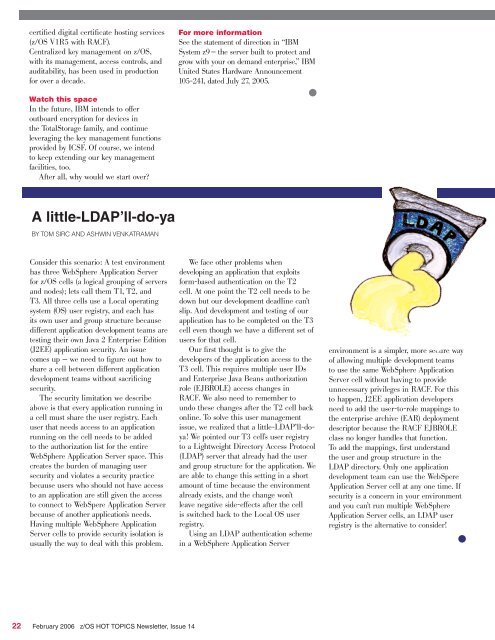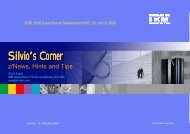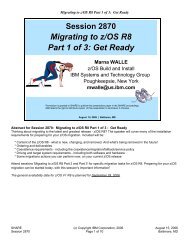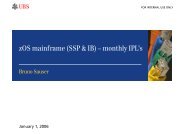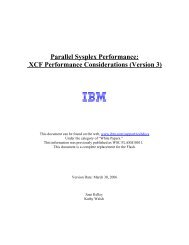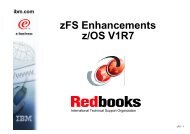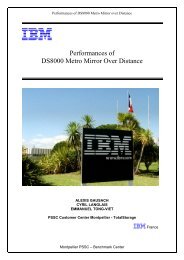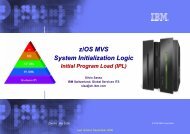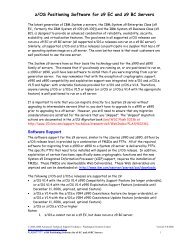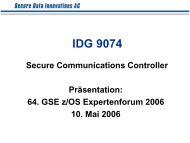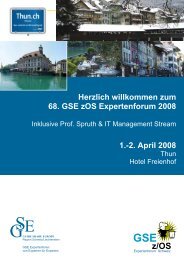Hot Topics - Messmer The Brain House
Hot Topics - Messmer The Brain House
Hot Topics - Messmer The Brain House
You also want an ePaper? Increase the reach of your titles
YUMPU automatically turns print PDFs into web optimized ePapers that Google loves.
certified digital certificate hosting services<br />
(z/OS V1R5 with RACF).<br />
Centralized key management on z/OS,<br />
with its management, access controls, and<br />
auditability, has been used in production<br />
for over a decade.<br />
Watch this space<br />
In the future, IBM intends to offer<br />
outboard encryption for devices in<br />
the TotalStorage family, and continue<br />
leveraging the key management functions<br />
provided by ICSF. Of course, we intend<br />
to keep extending our key management<br />
facilities, too.<br />
After all, why would we start over?<br />
A little-LDAP’ll-do-ya<br />
BY TOM SIRC AND ASHWIN VENKATRAMAN<br />
Consider this scenario: A test environment<br />
has three WebSphere Application Server<br />
for z/OS cells (a logical grouping of servers<br />
and nodes); lets call them T1, T2, and<br />
T3. All three cells use a Local operating<br />
system (OS) user registry, and each has<br />
its own user and group structure because<br />
different application development teams are<br />
testing their own Java 2 Enterprise Edition<br />
(J2EE) application security. An issue<br />
comes up — we need to figure out how to<br />
share a cell between different application<br />
development teams without sacrificing<br />
security.<br />
<strong>The</strong> security limitation we describe<br />
above is that every application running in<br />
a cell must share the user registry. Each<br />
user that needs access to an application<br />
running on the cell needs to be added<br />
to the authorization list for the entire<br />
WebSphere Application Server space. This<br />
creates the burden of managing user<br />
security and violates a security practice<br />
because users who should not have access<br />
to an application are still given the access<br />
to connect to WebSpere Application Server<br />
because of another application’s needs.<br />
Having multiple WebSphere Application<br />
Server cells to provide security isolation is<br />
usually the way to deal with this problem.<br />
22 February 2006 z/OS HOT TOPICS Newsletter, Issue 14<br />
For more information<br />
See the statement of direction in “IBM<br />
System z9— the server built to protect and<br />
grow with your on demand enterprise,” IBM<br />
United States Hardware Announcement<br />
105-241, dated July 27, 2005.<br />
We face other problems when<br />
developing an application that exploits<br />
form-based authentication on the T2<br />
cell. At one point the T2 cell needs to be<br />
down but our development deadline can’t<br />
slip. And development and testing of our<br />
application has to be completed on the T3<br />
cell even though we have a different set of<br />
users for that cell.<br />
Our first thought is to give the<br />
developers of the application access to the<br />
T3 cell. This requires multiple user IDs<br />
and Enterprise Java Beans authorization<br />
role (EJBROLE) access changes in<br />
RACF. We also need to remember to<br />
undo these changes after the T2 cell back<br />
online. To solve this user management<br />
issue, we realized that a little-LDAP’ll-doya!<br />
We pointed our T3 cell’s user registry<br />
to a Lightweight Directory Access Protocol<br />
(LDAP) server that already had the user<br />
and group structure for the application. We<br />
are able to change this setting in a short<br />
amount of time because the environment<br />
already exists, and the change won’t<br />
leave negative side-effects after the cell<br />
is switched back to the Local OS user<br />
registry.<br />
Using an LDAP authentication scheme<br />
in a WebSphere Application Server<br />
environment is a simpler, more secure way<br />
of allowing multiple development teams<br />
to use the same WebSphere Application<br />
Server cell without having to provide<br />
unnecessary privileges in RACF. For this<br />
to happen, J2EE application developers<br />
need to add the user-to-role mappings to<br />
the enterprise archive (EAR) deployment<br />
descriptor because the RACF EJBROLE<br />
class no longer handles that function.<br />
To add the mappings, first understand<br />
the user and group structure in the<br />
LDAP directory. Only one application<br />
development team can use the WebSpere<br />
Application Server cell at any one time. If<br />
security is a concern in your environment<br />
and you can’t run multiple WebSphere<br />
Application Server cells, an LDAP user<br />
registry is the alternative to consider!


